Sensitivity Analysis of Influencing Factors of Karst Tunnel Construction Based on Orthogonal Tests and a Random Forest Algorithm
Abstract
1. Introduction
2. Acquisition of the Original Database
2.1. Influencing Factors and Levels
2.2. Designation of Representative Measurement Points
3. Sensitivity Analysis of Influencing Factors
3.1. Range Analysis
3.2. Analysis of Variance (ANOVA)
3.3. Random Forest Model
- (1)
- The original training set should be obtained. Initially, a bootstrap resampling technique is applied to generate a new set of training samples by randomly sampling various samples from the original training sample set in a relaxed manner;
- (2)
- The training sets and test sets should be divided from the original sample set following the appropriate ratio, and the root nodes and leaf nodes should be trained to determine the number of decision trees, the depth of decision trees, and the number of features to be applied to train the leaf nodes of each decision tree;
- (3)
- The trained random forest model should be adopted to predict the test set. The prediction accuracy should be adjusted until it fulfils the requirements of prediction accuracy. The variables of the trained random forest model should be subjected to feature importance analysis, the feature importance score of each influencing factor should be calculated, and the feature importance results should be visualised.
3.4. Feature Importance Ranking
3.5. Optimal Combination of Results
4. Conclusions
Author Contributions
Funding
Institutional Review Board Statement
Informed Consent Statement
Data Availability Statement
Acknowledgments
Conflicts of Interest
References
- Mahmoudi, M.; Rajabi, A.M. A numerical simulation using FLAC3D to analyze the impact of concealed karstic caves on the behavior of adjacent tunnels. Nat. Hazards 2023, 117, 555–577. [Google Scholar] [CrossRef]
- Wu, W.; Liu, X.; Guo, J.; Sun, F.; Huang, X.; Zhu, Z. Upper limit analysis of stability of the water-resistant rock mass of a Karst tunnel face considering the seepage force. Bull. Eng. Geol. Environ. 2021, 80, 5813–5830. [Google Scholar] [CrossRef]
- Liu, N.; Pei, J.; Cao, C.; Liu, X.; Huang, Y.; Mei, G. Geological investigation and treatment measures against water inrush hazard in karst tunnels: A case study in Guiyang, southwest China. Tunn. Undergr. Space Technol. 2022, 124, 104491. [Google Scholar] [CrossRef]
- Wu, B.; Sun, W.; Cai, G.; Meng, G. Reliability analysis of shallow-buried tunnel construction adjacent to karst cave. Comput. Geotech. 2022, 145, 104673. [Google Scholar] [CrossRef]
- Cheng, W.; Cui, Q.; Shen, J.S.; Arulrajah, A.; Yuan, D. Fractal Prediction of Grouting Volume for Treating Karst Caverns along a Shield Tunneling Alignment. Appl. Sci. 2017, 7, 652. [Google Scholar] [CrossRef]
- Shi, Z.; Wang, Q.; Pang, C.; Yuan, Y.; Wang, F.; Song, H.; Liu, J.; Zhang, Z.; Sun, R.; Liu, Y. Establishment and Application of the Spatial Decomposition Method (SDM) for Tunnels Passing Through Large Karst Caves. Appl. Sci. 2020, 10, 7204. [Google Scholar] [CrossRef]
- Wang, X.; Lai, J.; He, S.; Garnes, R.S.; Zhang, Y. Karst geology and mitigation measures for hazards during metro system construction in Wuhan, China. Nat. Hazards 2020, 103, 2905–2927. [Google Scholar] [CrossRef]
- Liu, Y.; Feng, Y.; Xu, M.; Zhang, Y.; Long, H.; Zhu, H. Effect of an incremental change in external water pressure on tunnel lining: A case study from the Tongxi karst tunnel. Nat. Hazards 2019, 98, 343–377. [Google Scholar] [CrossRef]
- Yu, K.; Ren, F.; Puscasu, R.; Lin, P.; Meng, Q. Optimization of combined support in soft-rock roadway. Tunn. Undergr. Space Technol. 2020, 103, 103502. [Google Scholar] [CrossRef]
- Tian, H.; Chen, W.; Yang, D.; Dai, Y.; Yang, J. Application of the orthogonal design method in geotechnical parameter back analysis for underground structures. Bull. Eng. Geol. Environ. 2016, 75, 239–249. [Google Scholar] [CrossRef]
- Tian, Q.; Zhang, J.; Zhang, Y. Similar simulation experiment of expressway tunnel in karst area. Constr. Build. Mater. 2018, 176, 1–13. [Google Scholar] [CrossRef]
- Su, Y.; Sun, W.; Fang, Y. Analysis on displacement release of tunnel face based on orthogonal tests. J. Hunan Univ. (Nat. Sci.) 2017, 44, 156–163. (In Chinese) [Google Scholar]
- Han, G.; Xue, P.; Wang, Y.; Li, X.; Bian, H.; Wang, Y.; Guo, P. Mechanical response law and parameter influence analysis of karst tunnel dynamic excavation. Appl. Sci. 2023, 13, 9351. [Google Scholar] [CrossRef]
- Li, Q.; Meng, X.; Liu, Y. Sensitivity analysis of water inrush evaluation model based on the theory of water resistant key strata: A case study in a coal mine, China. Earth Sci. Inform. 2022, 15, 2481–2494. [Google Scholar] [CrossRef]
- Cheng, Y.; Zhou, W.; Xu, T. Tunneling-induced settlement prediction using the hybrid feature selection method for feature optimization. Transp. Geotech. 2022, 36, 100808. [Google Scholar] [CrossRef]
- Jang, H.; Kawamura, Y.; Shinji, U. An empirical approach of overbreak resistance factor for tunnel blasting. Tunn. Undergr. Space Technol. 2019, 92, 103060. [Google Scholar] [CrossRef]
- Zhao, C.; Lavasan, A.A.; Hölter, R.; Schanz, T. Mechanized tunneling induced building settlements and design of optimal monitoring strategies based on sensitivity field. Comput. Geotech. 2018, 97, 246–260. [Google Scholar] [CrossRef]
- Zhang, L.; Wu, X.; Zhu, H.; AbouRizk, S.M. Performing global uncertainty and sensitivity analysis from given data in tunnel construction. J. Comput. Civil Eng. 2017, 31, 04017065. [Google Scholar] [CrossRef]
- Pandit, B.; Babu, G.L.S. Global Sensitivity Analysis for a Tunnel-Support System in Weak Rock Mass for Both—Uncorrelated and Correlated Input Parameters. Rock Mech. Rock Eng. 2022, 55, 2787–2804. [Google Scholar] [CrossRef]
- Miro, S.; Hartmann, D.; Schanz, T. Global sensitivity analysis for subsoil parameter estimation in mechanized tunneling. Comput. Geotech. 2014, 56, 80–88. [Google Scholar] [CrossRef]
- Fellin, W.; King, J.; Kirsch, A.; Oberguggenberger, M. Uncertainty modelling and sensitivity analysis of tunnel face stability. Struct. Saf. 2010, 32, 402–410. [Google Scholar] [CrossRef]
- Chen, L.; Wang, Z.; Zhang, W.; Wang, Y. Characteristics, numerical analysis and countermeasures of mud inrush geohazards of Mountain tunnel in karst region. Geomat. Nat. Hazards Risk 2023, 14, 2242691. [Google Scholar] [CrossRef]
- Zhang, Z.; Li, G.; Zhang, G.; Niu, M. Influence of liquid accelerators on shotcrete in karst area tunnels. Case Stud. Constr. Mat. 2022, 16, e01002. [Google Scholar] [CrossRef]
- Li, S.; Gao, C.; Zhou, Z.; Li, L.; Wang, M.; Yuan, Y.; Wang, J. Analysis on the Precursor Information of Water Inrush in Karst Tunnels: A True Triaxial Model Test Study. Rock Mech. Rock Eng. 2019, 52, 373–384. [Google Scholar] [CrossRef]
- Feng, T.; Wang, C.; Zhang, J.P.; Wang, B.; Jin, Y. An improved artificial bee colony-random forest (IABC-RF) model for predicting the tunnel deformation due to an adjacent foundation pit excavation. Undergr. Space 2022, 7, 514–527. [Google Scholar] [CrossRef]
- Hao, Y.; Rong, X.; Lu, H.; Xiong, Z.; Dong, X. Quantification of margins and uncertainties for the risk of water inrush in a karst tunnel: Representations of epistemic uncertainty with probability. Arab. J. Sci. Eng. 2018, 43, 1627–1640. [Google Scholar] [CrossRef]
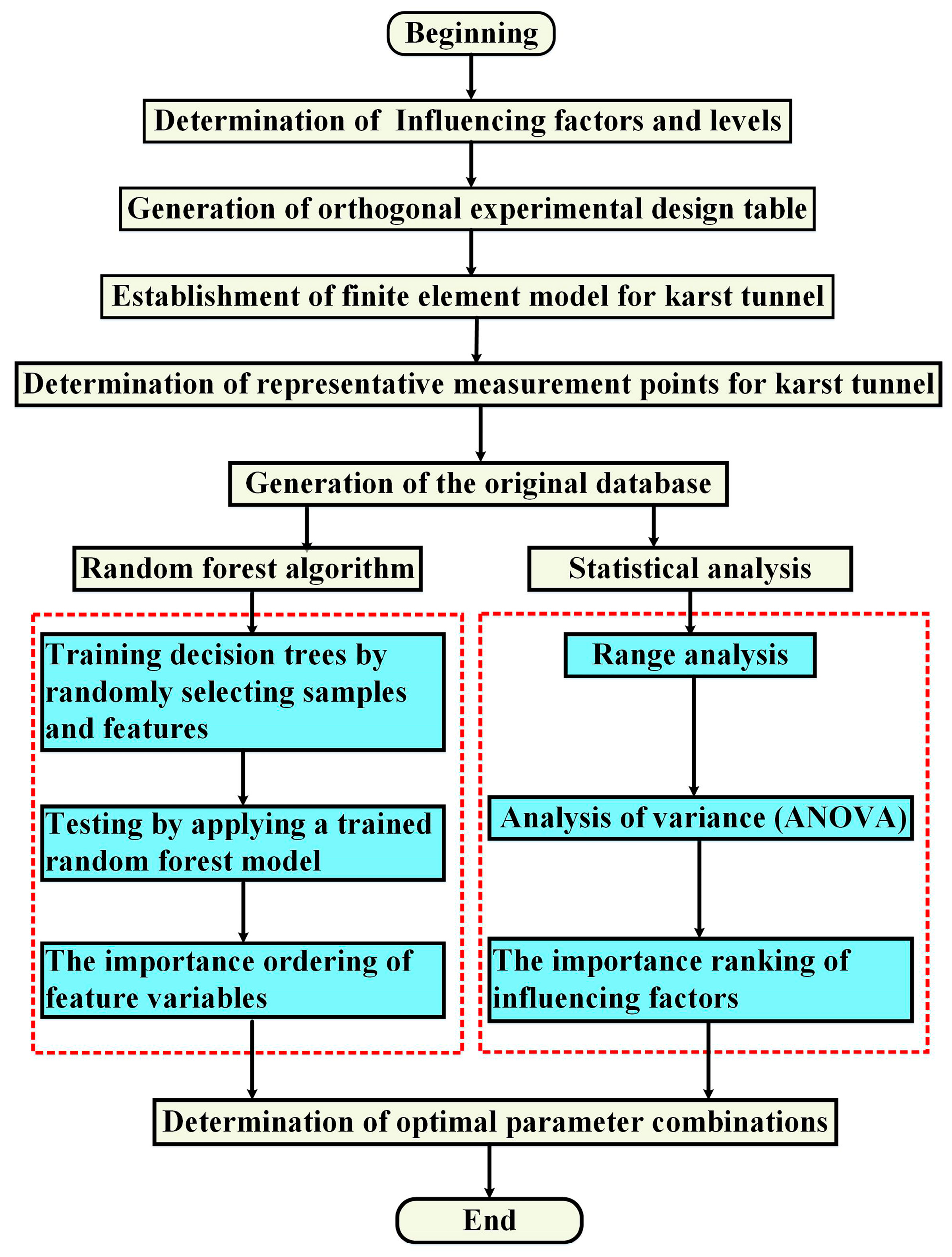
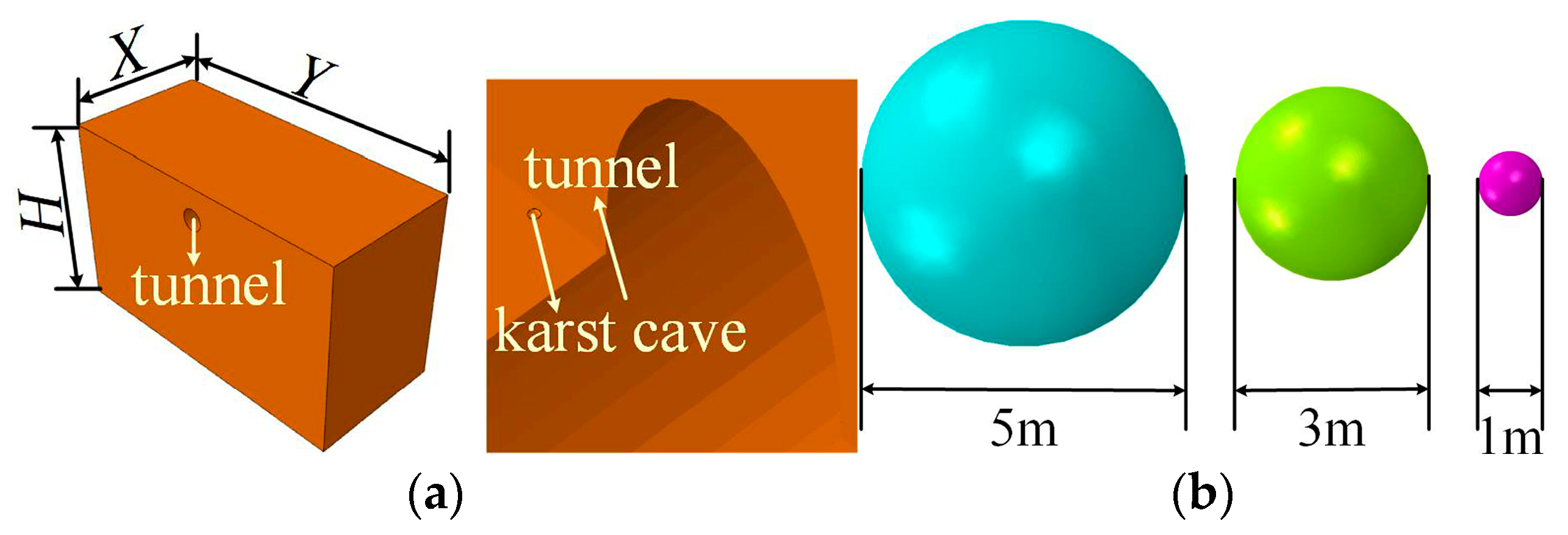


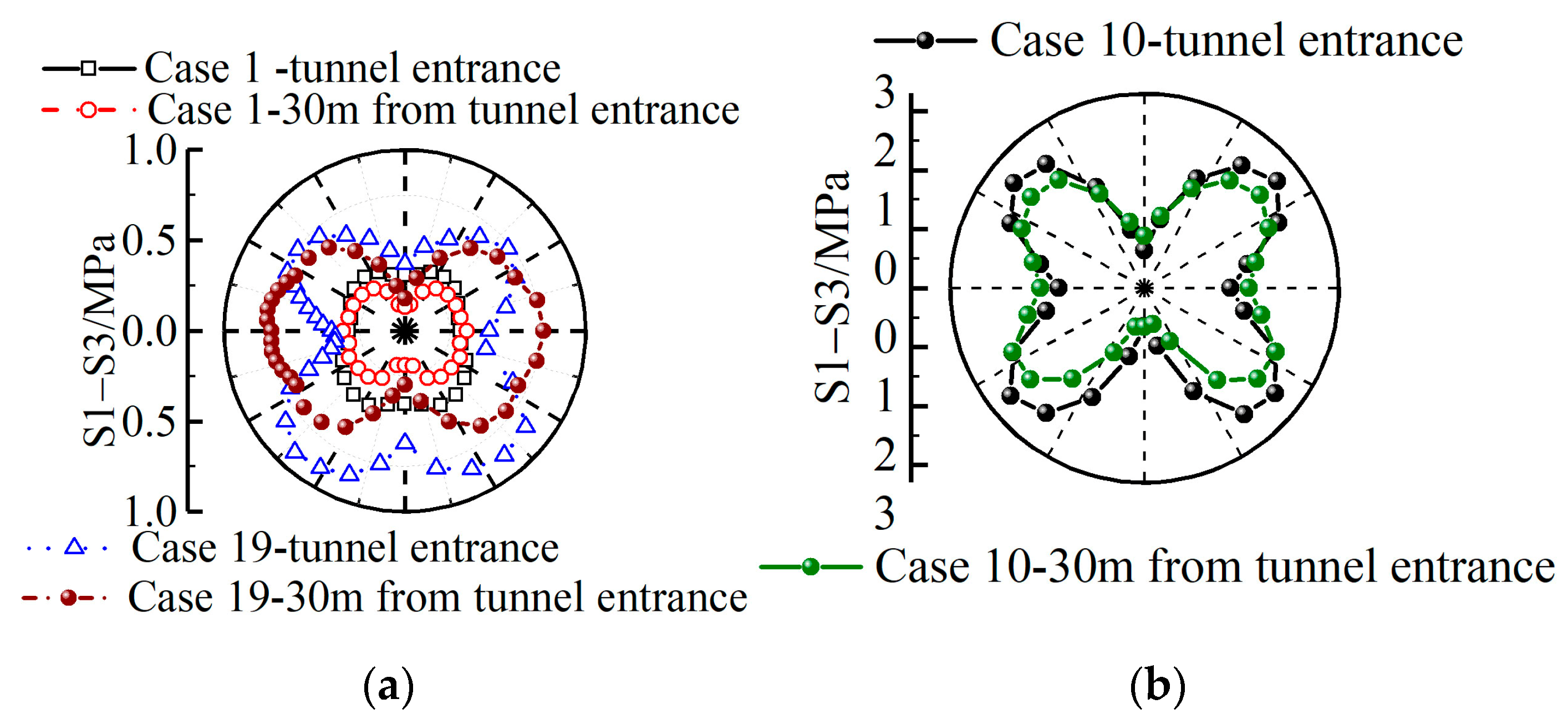

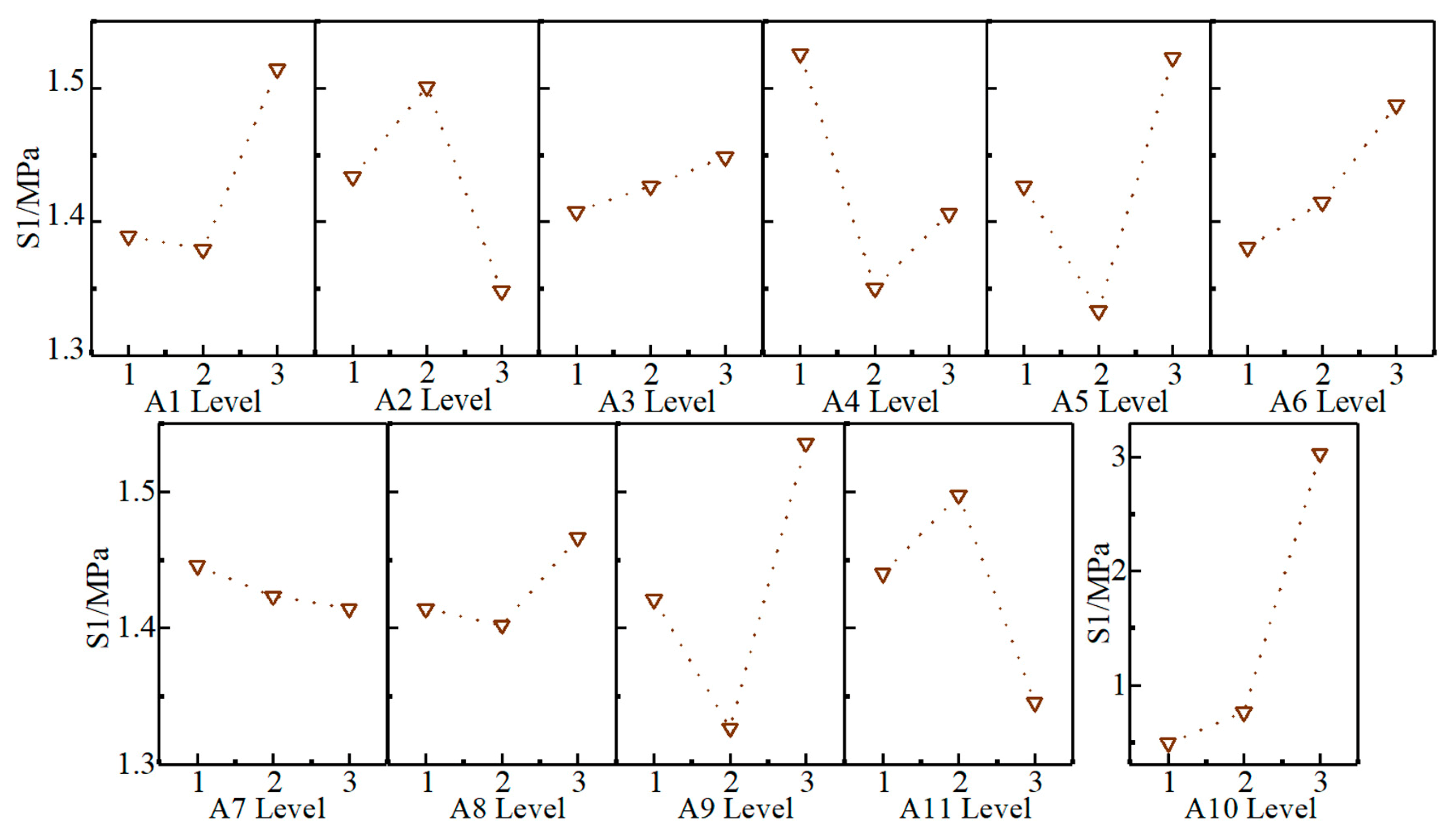

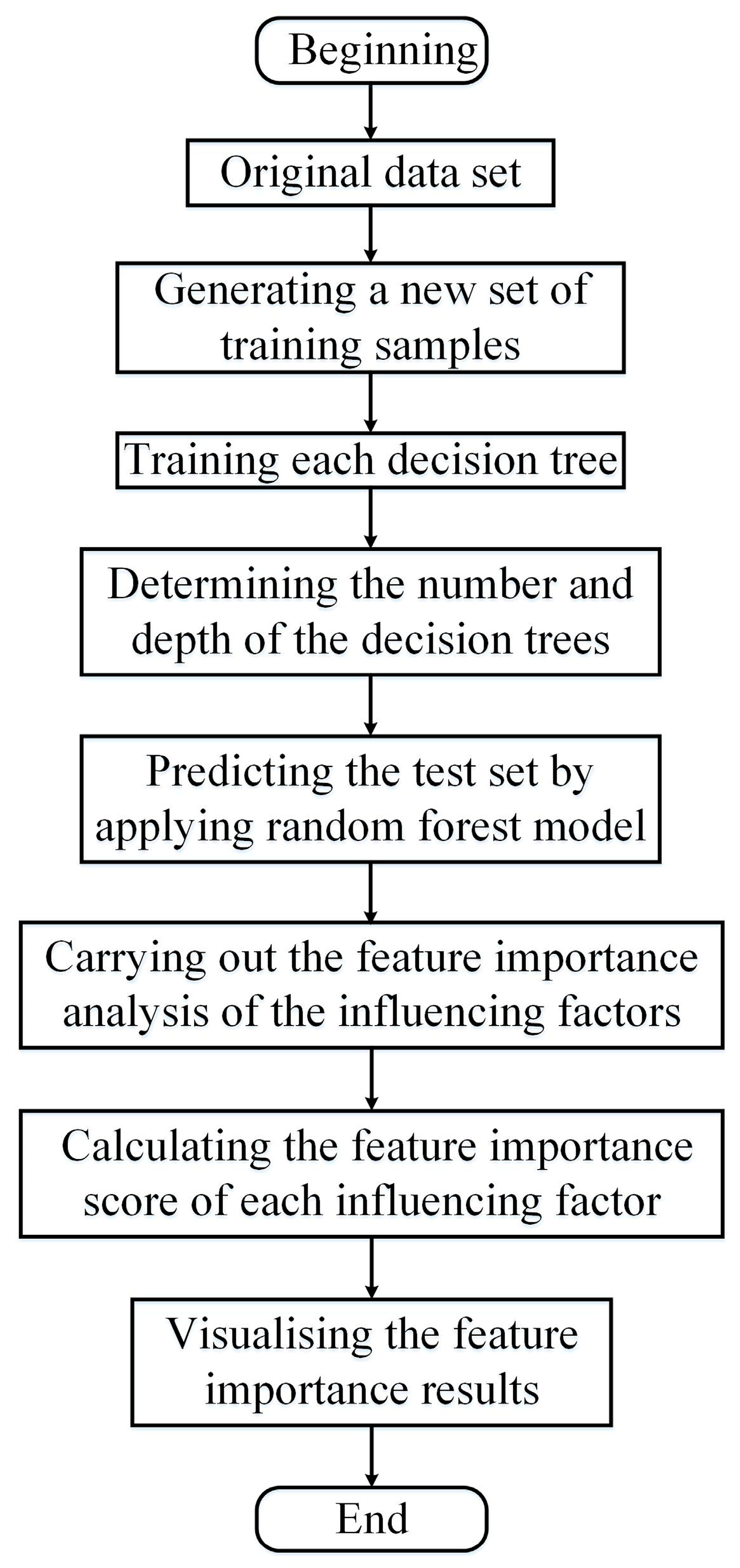

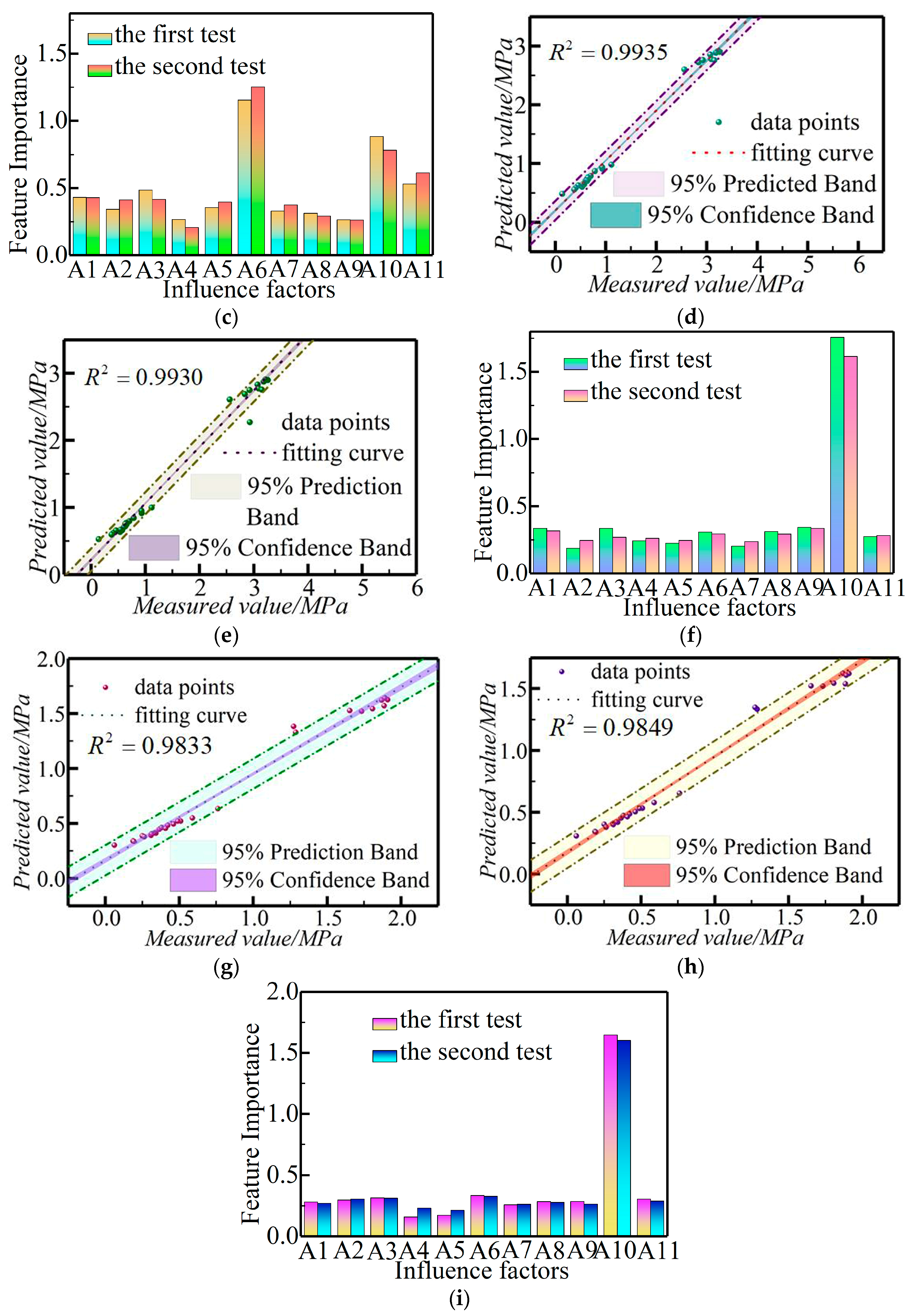

| Influencing factors | Elastic modulus | Poisson’s ratio | Geotechnical weight | Cohesion | Internal friction angle | Tunnel diameter |
| Label symbol | A1 | A2 | A3 | A4 | A5 | A6 |
| Influencing factors | The diameter of the karst cave | Clear distance between the tunnel and karst cave | Location of the karst cave | Tunnel buried depth | Excavation dimension | |
| Label symbol | A7 | A8 | A9 | A10 | A11 | |
| Levels | A1 | A2 | A3 | A4 | A5 | A6 | A7 | A8 | A9 | A10 | A11 |
|---|---|---|---|---|---|---|---|---|---|---|---|
| 1 | 40 | 0.25 | 25 | 800 | 36 | 3.35 | 1 | 1 | up | 13.4 | 1 |
| 2 | 53 | 0.3 | 27 | 1000 | 45 | 6.7 | 3 | 3 | down | 20.1 | 1.5 |
| 3 | 70 | 0.35 | 28 | 1200 | 54 | 13.4 | 5 | 5 | left | 100 | 2 |
| Case | A1 | A2 | A3 | A4 | A5 | A6 | A7 | A8 | A9 | A10 | A11 | d /mm | S1 /MPa | S1–S3 /MPa |
|---|---|---|---|---|---|---|---|---|---|---|---|---|---|---|
| 1 | 1 | 1 | 1 | 1 | 1 | 1 | 1 | 1 | 1 | 1 | 1 | 17.264 | 0.532 | 0.342 |
| 2 | 1 | 1 | 1 | 1 | 2 | 2 | 2 | 2 | 2 | 2 | 2 | 56.584 | 0.629 | 0.422 |
| 3 | 1 | 1 | 1 | 1 | 3 | 3 | 3 | 3 | 3 | 3 | 3 | 435.282 | 3.260 | 1.806 |
| 4 | 1 | 2 | 2 | 2 | 1 | 1 | 1 | 2 | 2 | 2 | 3 | 16.183 | 0.456 | 0.250 |
| 5 | 1 | 2 | 2 | 2 | 2 | 2 | 2 | 3 | 3 | 3 | 1 | 158.929 | 3.069 | 1.732 |
| 6 | 1 | 2 | 2 | 2 | 3 | 3 | 3 | 1 | 1 | 1 | 2 | 160.750 | 0.629 | 0.365 |
| 7 | 1 | 3 | 3 | 3 | 1 | 1 | 1 | 3 | 3 | 3 | 2 | 76.042 | 3.091 | 1.287 |
| 8 | 1 | 3 | 3 | 3 | 2 | 2 | 2 | 1 | 1 | 1 | 3 | 9.025 | 0.137 | 0.061 |
| 9 | 1 | 3 | 3 | 3 | 3 | 3 | 3 | 2 | 2 | 2 | 1 | 135.449 | 0.701 | 0.380 |
| 10 | 2 | 1 | 2 | 3 | 1 | 2 | 3 | 1 | 2 | 3 | 1 | 119.484 | 2.836 | 1.868 |
| 11 | 2 | 1 | 2 | 3 | 2 | 3 | 1 | 2 | 3 | 1 | 2 | 121.792 | 0.602 | 0.461 |
| 12 | 2 | 1 | 2 | 3 | 3 | 1 | 2 | 3 | 1 | 2 | 3 | 15.486 | 0.652 | 0.407 |
| 13 | 2 | 2 | 3 | 1 | 1 | 2 | 3 | 2 | 3 | 1 | 3 | 30.581 | 0.571 | 0.263 |
| 14 | 2 | 2 | 3 | 1 | 2 | 3 | 1 | 3 | 1 | 2 | 1 | 135.750 | 0.931 | 0.509 |
| 15 | 2 | 2 | 3 | 1 | 3 | 1 | 2 | 1 | 2 | 3 | 2 | 50.517 | 3.214 | 1.652 |
| 16 | 2 | 3 | 1 | 2 | 1 | 2 | 3 | 3 | 1 | 2 | 2 | 33.135 | 0.649 | 0.332 |
| 17 | 2 | 3 | 1 | 2 | 2 | 3 | 1 | 1 | 2 | 3 | 3 | 100.367 | 2.557 | 1.885 |
| 18 | 2 | 3 | 1 | 2 | 3 | 1 | 2 | 2 | 3 | 1 | 1 | 8.976 | 0.405 | 0.187 |
| 19 | 3 | 1 | 3 | 2 | 1 | 3 | 2 | 1 | 3 | 2 | 1 | 114.615 | 0.926 | 0.761 |
| 20 | 3 | 1 | 3 | 2 | 2 | 1 | 3 | 2 | 1 | 3 | 2 | 53.762 | 2.922 | 1.909 |
| 21 | 3 | 1 | 3 | 2 | 3 | 2 | 1 | 3 | 2 | 1 | 3 | 27.721 | 0.544 | 0.309 |
| 22 | 3 | 2 | 1 | 3 | 1 | 3 | 2 | 2 | 1 | 3 | 3 | 231.204 | 3.151 | 1.890 |
| 23 | 3 | 2 | 1 | 3 | 2 | 1 | 3 | 3 | 2 | 1 | 1 | 6.284 | 0.376 | 0.193 |
| 24 | 3 | 2 | 1 | 3 | 3 | 2 | 1 | 1 | 3 | 2 | 2 | 29.847 | 1.113 | 0.589 |
| 25 | 3 | 3 | 2 | 1 | 1 | 3 | 2 | 3 | 2 | 1 | 2 | 76.615 | 0.628 | 0.312 |
| 26 | 3 | 3 | 2 | 1 | 2 | 1 | 3 | 1 | 3 | 2 | 3 | 11.046 | 0.783 | 0.49 |
| 27 | 3 | 3 | 2 | 1 | 3 | 2 | 1 | 2 | 1 | 3 | 1 | 86.950 | 3.185 | 1.273 |
| Ranking of Influencing Factors | The First Category | The Secondary Category | The Third Category | ||||||||
|---|---|---|---|---|---|---|---|---|---|---|---|
| 1 | 2 | 3 | 4 | 5 | 6 | 7 | 8 | 9 | 10 | 11 | |
| d | A6 | A10 | A1 | A2 | A9 | A7 | A8 | A5 | A3 | A4 | A11 |
| S1 | A10 | A9 | A5 | A4 | A2 | A11 | A1 | A6 | A8 | A3 | A7 |
| S1–S3 | A10 | A2 | A6 | A8 | A1 | A7 | A5 | A4 | A3 | A9 | A11 |
| Target Variable | A1 | A2 | A3 | A4 | A5 | A6 | A7 | A8 | A9 | A10 | A11 | |
|---|---|---|---|---|---|---|---|---|---|---|---|---|
| d | F value | 0.44 | 0.60 | 0.26 | 0.17 | 0.31 | 9.53 | 0.47 | 0.40 | 0.52 | 3.50 | 0.15 |
| p value | 0.85 | 0.56 | 0.78 | 0.85 | 0.74 | 0.001 | 0.63 | 0.67 | 0.60 | 0.046 | 0.86 | |
| S1 | F value | 0.03 | 0.04 | 0.00 | 0.05 | 0.05 | 0.02 | 0.00 | 0.01 | 0.07 | 452.50 | 0.04 |
| p value | 0.97 | 0.97 | 1.00 | 0.95 | 0.95 | 0.98 | 1.00 | 0.99 | 0.94 | 0.00 | 0.97 | |
| S1–S3 | F value | 0.08 | 0.26 | 0.02 | 0.03 | 0.03 | 0.20 | 0.03 | 0.09 | 0.01 | 161.58 | 0.00 |
| p value | 0.93 | 0.78 | 0.98 | 0.97 | 0.97 | 0.82 | 0.97 | 0.92 | 0.99 | 0.00 | 1.00 | |
| Ranking of Influencing Factors | The First Category | The Secondary Category | The Third Category | |||||||||
|---|---|---|---|---|---|---|---|---|---|---|---|---|
| 1 | 2 | 3 | 4 | 5 | 6 | 7 | 8 | 9 | 10 | 11 | ||
| d | first test | A6 | A10 | A11 | A3 | A1 | A5 | A2 | A7 | A8 | A4 | A9 |
| second test | A6 | A10 | A11 | A1 | A3 | A2 | A5 | A7 | A8 | A9 | A4 | |
| S1 | first test | A10 | A9 | A3 | A1 | A8 | A6 | A11 | A4 | A5 | A7 | A2 |
| second test | A10 | A9 | A1 | A6 | A8 | A11 | A3 | A4 | A5 | A2 | A7 | |
| S1–S3 | first test | A10 | A6 | A3 | A11 | A2 | A9 | A8 | A1 | A7 | A5 | A4 |
| second test | A10 | A6 | A3 | A2 | A11 | A8 | A1 | A9 | A7 | A4 | A5 | |
| Case | A1 | A2 | A3 | A4 | A5 | A6 | A7 | A8 | A9 | A10 | A11 | d /mm | S1 /MPa | S1–S3 /MPa |
|---|---|---|---|---|---|---|---|---|---|---|---|---|---|---|
| B1 | 53 | 0.3 | 27 | 1000 | 45 | 6.7 | 3 | 3 | down | 20.1 | 1 | 140.20 | 0.572 | 0.197 |
| B2 | 53 | 0.35 | 28 | 1000 | 45 | 3.35 | 1 | 1 | down | 13.4 | 1.5 | 79.93 | 0.607 | 0.069 |
| B3 | 53 | 0.35 | 25 | 1000 | 45 | 3.35 | 5 | 3 | down | 100 | 1 | 349.72 | 0.472 | 0.475 |
| B4 | 40 | 0.35 | 27 | 800 | 54 | 3.35 | 1 | 1 | up | 13.4 | 1 | 78.17 | 0.529 | 0.144 |
Disclaimer/Publisher’s Note: The statements, opinions and data contained in all publications are solely those of the individual author(s) and contributor(s) and not of MDPI and/or the editor(s). MDPI and/or the editor(s) disclaim responsibility for any injury to people or property resulting from any ideas, methods, instructions or products referred to in the content. |
© 2024 by the authors. Licensee MDPI, Basel, Switzerland. This article is an open access article distributed under the terms and conditions of the Creative Commons Attribution (CC BY) license (https://creativecommons.org/licenses/by/4.0/).
Share and Cite
Wu, B.; Sun, W.; Meng, G. Sensitivity Analysis of Influencing Factors of Karst Tunnel Construction Based on Orthogonal Tests and a Random Forest Algorithm. Appl. Sci. 2024, 14, 2079. https://doi.org/10.3390/app14052079
Wu B, Sun W, Meng G. Sensitivity Analysis of Influencing Factors of Karst Tunnel Construction Based on Orthogonal Tests and a Random Forest Algorithm. Applied Sciences. 2024; 14(5):2079. https://doi.org/10.3390/app14052079
Chicago/Turabian StyleWu, Bo, Wentao Sun, and Guowang Meng. 2024. "Sensitivity Analysis of Influencing Factors of Karst Tunnel Construction Based on Orthogonal Tests and a Random Forest Algorithm" Applied Sciences 14, no. 5: 2079. https://doi.org/10.3390/app14052079
APA StyleWu, B., Sun, W., & Meng, G. (2024). Sensitivity Analysis of Influencing Factors of Karst Tunnel Construction Based on Orthogonal Tests and a Random Forest Algorithm. Applied Sciences, 14(5), 2079. https://doi.org/10.3390/app14052079





